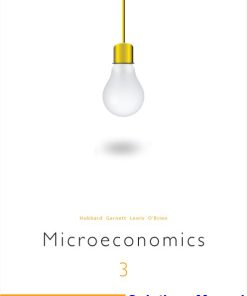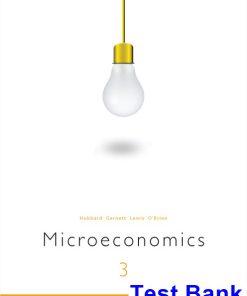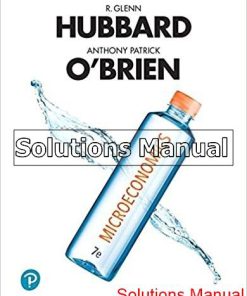Microeconomics 7th Edition Hubbard Test Bank
$50.00 Original price was: $50.00.$26.50Current price is: $26.50.
Microeconomics 7th Edition Hubbard Test Bank.
This is completed downloadable of Microeconomics 7th Edition Hubbard Test Bank

Product Details:
- ISBN-10 : 0134737504
- ISBN-13 : 978-0134737508
- Author: Glenn Hubbard (Author), Anthony O’Brien (Author)
One of the challenges of teaching principles of microeconomics is fostering interest in concepts that may not seem applicable to students’ lives. Microeconomicsmakes this topic relevant by demonstrating how real businesses use microeconomics to make decisions every day. With ever-changing US and world economies, the 7th Edition has been updated with the latest developments using new real-world business and policy examples. Regardless of their future career path — opening an art studio, trading on Wall Street, or bartending at the local pub, students will benefit from understanding the economic forces behind their work.
Table of Content:
- Part 1 Introduction
- 1 Economics: Foundations and Models
- Chapter Outline & Learning Objectives
- 1.1 Three Key Economic Ideas
- People Are Rational
- People Respond to Economic Incentives
- Optimal Decisions Are Made at the Margin
- 1.2 The Economic Problem That Every Society Must Solve
- What Goods and Services Will Be Produced?
- How Will the Goods and Services Be Produced?
- Who Will Receive the Goods and Services Produced?
- Centrally Planned Economies versus Market Economies
- The Modern “Mixed” Economy
- Efficiency and Equity
- 1.3 Economic Models
- The Role of Assumptions in Economic Models
- Forming and Testing Hypotheses in Economic Models
- Positive and Normative Analysis
- Economics as a Social Science
- 1.4 Microeconomics and Macroeconomics
- 1.5 Economic Skills and Economics as a Career
- 1.6 A Preview of Important Economic Terms
- Conclusion
- Chapter Summary and Problems
- Key Terms
- 1.1 Three Key Economic Ideas
- Summary
- Review Questions
- Problems and Applications
- 1.2 The Economic Problem That Every Society Must Solve
- Summary
- Review Questions
- Problems and Applications
- 1.3 Economic Models
- Summary
- Review Questions
- Problems and Applications
- 1.4 Microeconomics and Macroeconomics
- Summary
- Review Question
- Problems and Applications
- Critical Thinking Exercises
- Appendix Using Graphs and Formulas
- Graphs of One Variable
- Graphs of Two Variables
- Slopes of Lines
- Taking into Account More Than Two Variables on a Graph
- Positive and Negative Relationships
- Determining Cause and Effect
- Are Graphs of Economic Relationships Always Straight Lines?
- Slopes of Nonlinear Curves
- Formulas
- Formula for a Percentage Change
- Formulas for the Areas of a Rectangle and a Triangle
- Summary of Using Formulas
- 1A Using Graphs and Formulas, pages 28–38
- Problems and Applications
- 2 Trade-offs, Comparative Advantage, and the Market System
- Chapter Outline & Learning Objectives
- 2.1 Production Possibilities Frontiers and Opportunity Costs
- Graphing the Production Possibilities Frontier
- Increasing Marginal Opportunity Costs
- Economic Growth
- 2.2 Comparative Advantage and Trade
- Specialization and Gains from Trade
- Absolute Advantage versus Comparative Advantage
- Comparative Advantage and the Gains from Trade
- 2.3 The Market System
- The Circular Flow of Income
- The Gains from Free Markets
- The Market Mechanism
- The Role of the Entrepreneur in the Market System
- The Legal Basis of a Successful Market System
- Protection of Private Property
- Enforcement of Contracts and Property Rights
- Conclusion
- Chapter Summary and Problems
- Key Terms
- 2.1 Production Possibilities Frontiers and Opportunity Costs
- Summary
- Review Questions
- Problems and Applications
- 2.2 Comparative Advantage and Trade
- Summary
- Review Questions
- Problems and Applications
- 2.3 The Market System
- Summary
- Review Questions
- Problems and Applications
- Critical Thinking Exercises
- 3 Where Prices Come From: The Interaction of Demand and Supply
- Chapter Outline & Learning Objectives
- 3.1 The Demand Side of the Market
- Demand Schedules and Demand Curves
- The Law of Demand
- What Explains the Law of Demand?
- Holding Everything Else Constant: The Ceteris Paribus Condition
- Variables That Shift Market Demand
- Income
- Prices of Related Goods
- Tastes
- Population and Demographics
- Expected Future Prices
- A Change in Demand versus a Change in Quantity Demanded
- 3.2 The Supply Side of the Market
- Supply Schedules and Supply Curves
- The Law of Supply
- Variables That Shift Market Supply
- Prices of Inputs
- Technological Change
- Prices of Related Goods in Production
- Number of Firms in the Market
- Expected Future Prices
- A Change in Supply versus a Change in Quantity Supplied
- 3.3 Market Equilibrium: Putting Demand and Supply Together
- How Markets Eliminate Surpluses and Shortages
- Demand and Supply Both Count
- 3.4 The Effect of Demand and Supply Shifts on Equilibrium
- The Effect of Shifts in Demand on Equilibrium
- The Effect of Shifts in Supply on Equilibrium
- The Effect of Shifts in Demand and Supply over Time
- Shifts in a Curve versus Movements along a Curve
- Conclusion
- Chapter Summary and Problems
- Key Terms
- 3.1 The Demand Side of the Market
- Summary
- Review Questions
- Problems and Applications
- 3.2 The Supply Side of the Market
- Summary
- Review Questions
- Problems and Applications
- 3.3 Market Equilibrium: Putting Demand and Supply Together
- Summary
- Review Questions
- Problems and Applications
- 3.4 The Effect of Demand and Supply Shifts on Equilibrium
- Summary
- Review Questions
- Problems and Applications
- Critical Thinking Exercises
- 4 Economic Efficiency, Government Price Setting, and Taxes
- Chapter Outline & Learning Objectives
- 4.1 Consumer Surplus and Producer Surplus
- Consumer Surplus
- Producer Surplus
- What Consumer Surplus and Producer Surplus Measure
- 4.2 The Efficiency of Competitive Markets
- Marginal Benefit Equals Marginal Cost in Competitive Equilibrium
- Economic Surplus
- Deadweight Loss
- Economic Surplus and Economic Efficiency
- 4.3 Government Intervention in the Market: Price Floors and Price Ceilings
- Price Floors: Government Policy in Agricultural Markets
- Price Ceilings: Government Rent Control Policy in Housing Markets
- Black Markets and Peer-to-Peer Sites
- The Results of Government Price Controls: Winners, Losers, and Inefficiency
- Positive and Normative Analysis of Price Ceilings and Price Floors
- 4.4 The Economic Effect of Taxes
- The Effect of Taxes on Economic Efficiency
- Tax Incidence: Who Actually Pays a Tax?
- Determining Tax Incidence on a Demand and Supply Graph
- Does It Make a Difference Whether the Government Collects a Tax from Buyers or Sellers?
- Conclusion
- Chapter Summary and Problems
- Key Terms
- 4.1 Consumer Surplus and Producer Surplus
- Summary
- Review Questions
- Problems and Applications
- 4.2 The Efficiency of Competitive Markets
- Summary
- Review Questions
- Problems and Applications
- 4.3 Government Intervention in the Market: Price Floors and Price Ceilings
- Summary
- Review Questions
- Problems and Applications
- 4.4 The Economic Effect of Taxes
- Summary
- Review Questions
- Problems and Applications
- Critical Thinking Exercises
- Appendix Quantitative Demand and Supply Analysis
- Demand and Supply Equations
- Calculating Consumer Surplus and Producer Surplus
- 4A Quantitative Demand and Supply Analysis
- Review Questions
- Problems and Applications
- Part 2 Markets in Action: Policy and Applications
- 5 Externalities, Environmental Policy, and Public Goods
- Chapter Outline & Learning Objectives
- 5.1 Externalities and Economic Efficiency
- The Effect of Externalities
- How a Negative Externality in Production Reduces Economic Efficiency
- How a Positive Externality in Consumption Reduces Economic Efficiency
- Externalities and Market Failure
- What Causes Externalities?
- 5.2 Private Solutions to Externalities: The Coase Theorem
- The Economically Efficient Level of Pollution Reduction
- The Basis for Private Solutions to Externalities
- Do Property Rights Matter?
- The Problem of Transactions Costs
- The Coase Theorem
- 5.3 Government Policies to Deal with Externalities
- Imposing a Tax When There Is a Negative Externality
- Providing a Subsidy When There Is a Positive Externality
- Command-and-Control versus Market-Based Approaches
- The End of the Sulfur Dioxide Cap-and-Trade System
- Are Tradable Emission Allowances Licenses to Pollute?
- 5.4 Four Categories of Goods
- The Demand for a Public Good
- The Optimal Quantity of a Public Good
- Common Resources
- The Tragedy of the Commons
- Is There a Way out of the Tragedy of the Commons?
- Conclusion
- Chapter Summary and Problems
- Key Terms
- 5.1 Externalities and Economic Efficiency
- Summary
- Review Questions
- Problems and Applications
- 5.2 Private Solutions to Externalities: The Coase Theorem
- Summary
- Review Questions
- Problems and Applications
- 5.3 Government Policies to Deal with Externalities
- Summary
- Review Questions
- Problems and Applications
- 5.4 Four Categories of Goods
- Summary
- Review Questions
- Problems and Applications
- Critical Thinking Exercises
- 6 Elasticity: The Responsiveness of Demand and Supply
- Chapter Outline & Learning Objectives
- 6.1 The Price Elasticity of Demand and Its Measurement
- Measuring the Price Elasticity of Demand
- Elastic Demand and Inelastic Demand
- An Example of Calculating Price Elasticities
- The Midpoint Formula
- When Demand Curves Intersect, the Flatter Curve Is More Elastic
- Polar Cases of Perfectly Elastic and Perfectly Inelastic Demand
- 6.2 The Determinants of the Price Elasticity of Demand
- Availability of Close Substitutes
- Passage of Time
- Luxuries versus Necessities
- Definition of the Market
- Share of a Good in a Consumer’s Budget
- Some Estimated Price Elasticities of Demand
- 6.3 The Relationship between Price Elasticity of Demand and Total Revenue
- Elasticity and Revenue with a Linear Demand Curve
- 6.4 Other Demand Elasticities
- Cross-Price Elasticity of Demand
- Income Elasticity of Demand
- 6.5 Using Elasticity to Analyze the Disappearing Family Farm
- 6.6 The Price Elasticity of Supply and Its Measurement
- Measuring the Price Elasticity of Supply
- Determinants of the Price Elasticity of Supply
- Polar Cases of Perfectly Elastic and Perfectly Inelastic Supply
- Using Price Elasticity of Supply to Predict Changes in Price
- Conclusion
- Chapter Summary and Problems
- Key Terms
- 6.1 The Price Elasticity of Demand and Its Measurement
- Summary
- Review Questions
- Problems and Applications
- 6.2 The Determinants of the Price Elasticity of Demand
- Summary
- Review Questions
- Problems and Applications
- 6.3 The Relationship between Price Elasticity of Demand and Total Revenue
- Summary
- Review Questions
- Problems and Applications
- 6.4 Other Demand Elasticities
- Summary
- Review Questions
- Problems and Applications
- 6.5 Using Elasticity to Analyze the Disappearing Family Farm
- Summary
- Review Questions
- Problems and Applications
- 6.6 The Price Elasticity of Supply and Its Measurement
- Summary
- Review Questions
- Problems and Applications
- Critical Thinking Exercises
- 7 The Economics of Health Care
- Chapter Outline & Learning Objectives
- 7.1 The Improving Health of People in the United States
- Changes over Time in U.S. Health
- Reasons for Long-Run Improvements in U.S. Health
- 7.2 Health Care around the World
- The U.S. Health Care System
- The Health Care Systems of Canada, Japan, and the United Kingdom
- Canada
- Japan
- The United Kingdom
- Comparing Health Care Outcomes around the World
- How Useful Are Cross-Country Comparisons of Health Outcomes?
- 7.3 Information Problems and Externalities in the Market for Health Care
- Adverse Selection and the Market for “Lemons”
- Asymmetric Information in the Market for Health Insurance
- Adverse Selection in the Market for Health Insurance
- Moral Hazard in the Market for Health Insurance
- How Insurance Companies Deal with Adverse Selection and Moral Hazard
- Externalities in the Market for Health Care
- Should the Government Run the Health Care System?
- Is Health Care a Public Good?
- Do Externalities in Health Care Justify More Government Intervention?
- Do Information Problems with Health Care Justify More Government Intervention?
- Or Should There Be Greater Reliance on Market-Based Policies?
- 7.4 The Debate over Health Care Policy in the United States
- The Rising Cost of Health Care
- Explaining Increases in Health Care Spending
- Factors That Do Not Explain Sustained Increases in Health Care Spending
- “Cost Disease” in the Health Care Sector
- The Aging of the Population and Advances in Medical Technology
- Distorted Economic Incentives
- The Continuing Debate over Health Care Policy
- The Patient Protection and Affordable Care Act
- The Debate over the ACA
- Conclusion
- Chapter Summary and Problems
- Key Terms
- 7.1 The Improving Health of People in the United States
- Summary
- Review Questions
- Problems and Applications
- 7.2 Health Care around the World
- Summary
- Review Questions
- Problems and Applications
- 7.3 Information Problems and Externalities in the Market for Health Care
- Summary
- Review Questions
- Problems and Applications
- 7.4 The Debate over Health Care Policy in the United States
- Summary
- Review Questions
- Problems and Applications
- Critical Thinking Exercises
- Part 3 Firms in the Domestic and International Economies
- 8 Firms, the Stock Market, and Corporate Governance
- Chapter Outline & Learning Objectives
- 8.1 Types of Firms
- Who Is Liable? Limited and Unlimited Liability
- Corporations Earn the Majority of Revenue and Profits
- The Structure of Corporations and the Principal–Agent Problem
- 8.2 How Firms Raise Funds
- Sources of External Funds
- Bonds
- Stocks
- Stock and Bond Markets Provide Capital—and Information
- The Fluctuating Stock Market
- 8.3 Using Financial Statements to Evaluate a Corporation
- The Income Statement
- Accounting Profit
- Economic Profit
- The Balance Sheet
- 8.4 Recent Issues in Corporate Governance Policy
- The Accounting Scandals of the Early 2000s
- Corporate Governance and the Financial Crisis of 2007–2009
- Government Regulation in Response to the Financial Crisis
- Did Principal–Agent Problems Help Cause the 2007–2009 Financial Crisis?
- Conclusion
- Chapter Summary and Problems
- Key Terms
- 8.1 Types of Firms
- Summary
- Review Questions
- Problems and Applications
- 8.2 How Firms Raise Funds
- Summary
- Review Questions
- Problems and Applications
- 8.3 Using Financial Statements to Evaluate a Corporation
- Summary
- Review Questions
- Problems and Applications
- 8.4 Recent Issues in Corporate Governance Policy
- Summary
- Review Questions
- Problems and Applications
- Critical Thinking Exercises
- Appendix Tools to Analyze Firms’ Financial Information
- Using Present Value to Make Investment Decisions
- Using Present Value to Calculate Bond Prices
- Using Present Value to Calculate Stock Prices
- A Simple Formula for Calculating Stock Prices
- Going Deeper into Financial Statements
- Analyzing Income Statements
- Analyzing Balance Sheets
- Key Terms
- Tools to Analyze Firms’ Financial Information
- Review Questions
- Problems and Applications
- 9 Comparative Advantage and the Gains from International Trade
- Chapter Outline & Learning Objectives
- 9.1 The United States in the International Economy
- The Importance of Trade to the U.S. Economy
- U.S. International Trade in a World Context
- 9.2 Comparative Advantage in International Trade
- A Brief Review of Comparative Advantage
- Comparative Advantage and Absolute Advantage
- 9.3 How Countries Gain from International Trade
- Increasing Consumption through Trade
- Why Don’t We See Complete Specialization?
- Does Anyone Lose as a Result of International Trade?
- Where Does Comparative Advantage Come From?
- 9.4 Government Policies That Restrict International Trade
- Tariffs
- Quotas and Voluntary Export Restraints
- Measuring the Economic Effect of the Sugar Quota
- The High Cost of Preserving Jobs with Tariffs and Quotas
- Gains from Unilateral Elimination of Tariffs and Quotas
- Other Barriers to Trade
- 9.5 The Debate over Trade Policies and Globalization
- Why Do Some People Oppose the World Trade Organization?
- Anti-globalization
- “Old-Fashioned” Protectionism
- Dumping
- Positive versus Normative Analysis (Once Again)
- Conclusion
- Chapter Summary and Problems
- Key Terms
- 9.1 The United States in the International Economy
- Summary
- Review Questions
- Problems and Applications
- 9.2 Comparative Advantage in International Trade
- Summary
- Review Questions
- Problems and Applications
- 9.3 How Countries Gain from International Trade
- Summary
- Review Questions
- Problems and Applications
- 9.4 Government Policies That Restrict International Trade
- Summary
- Review Questions
- Problems and Applications
- 9.5 The Debate over Trade Policies and Globalization
- Summary
- Review Questions
- Problems and Applications
- Critical Thinking Exercises
- Part 4 Microeconomic Foundations: Consumers and Firms
- 10 Consumer Choice and Behavioral Economics
- Chapter Outline & Learning Objectives
- 10.1 Utility and Consumer Decision Making
- An Overview of the Economic Model of Consumer Behavior
- Utility
- The Principle of Diminishing Marginal Utility
- The Rule of Equal Marginal Utility per Dollar Spent
- What if the Rule of Equal Marginal Utility per Dollar Does Not Hold?
- The Income Effect and Substitution Effect of a Price Change
- The Income Effect
- The Substitution Effect
- 10.2 Where Demand Curves Come From
- 10.3 Social Influences on Decision Making
- The Effects of Celebrity Endorsements
- Network Externalities
- There’s Strength in Numbers
- Do Switching Costs Cause Inferior Technologies to Survive?
- Do Network Externalities Result in Market Failure?
- Does Fairness Matter?
- A Test of Fairness in the Economic Laboratory: The Ultimatum Game Experiment
- Are the Results of Economic Experiments Reliable?
- Business Implications of Fairness
- 10.4 Behavioral Economics: Do People Make Rational Choices?
- Pitfalls in Decision Making
- Ignoring Nonmonetary Opportunity Costs
- Failing to Ignore Sunk Costs
- Being Unrealistic about Future Behavior
- “Nudges”: Using Behavioral Economics to Guide Behavior
- The Behavioral Economics of Shopping
- Rules of Thumb
- Anchoring
- Conclusion
- Chapter Summary and Problems
- Key Terms
- 10.1 Utility and Consumer Decision Making
- Summary
- Review Questions
- Problems and Applications
- 10.2 Where Demand Curves Come From
- Summary
- Review Questions
- Problems and Applications
- 10.3 Social Influences on Decision Making
- Summary
- Review Questions
- Problems and Applications
- 10.4 Behavioral Economics: Do People Make Rational Choices?
- Summary
- Review Questions
- Problems and Applications
- Critical Thinking Exercises
- Appendix Using Indifference Curves and Budget Lines to Understand Consumer Behavior
- Consumer Preferences
- Indifference Curves
- The Slope of an Indifference Curve
- Can Indifference Curves Ever Cross?
- The Budget Constraint
- Choosing the Optimal Consumption of Pizza and Coke
- Deriving the Demand Curve
- The Income Effect and the Substitution Effect of a Price Change
- How a Change in Income Affects Optimal Consumption
- The Slope of the Indifference Curve, the Slope of the Budget Line, and the Rule of Equal Marginal Utility per Dollar Spent
- The Rule of Equal Marginal Utility per Dollar Spent Revisited
- Key Terms
- 10.A Using Indifference Curves and Budget Lines to Understand Consumer Behavior
- Review Questions
- Problems and Applications
- 11 Technology, Production, and Costs
- Chapter Outline & Learning Objectives
- 11.1 Technology: An Economic Definition
- 11.2 The Short Run and the Long Run in Economics
- The Difference between Fixed Costs and Variable Costs
- Implicit Costs versus Explicit Costs
- The Production Function
- A First Look at the Relationship between Production and Cost
- 11.3 The Marginal Product of Labor and the Average Product of Labor
- The Law of Diminishing Returns
- Graphing Production
- The Relationship between Marginal Product and Average Product
- An Example of Marginal and Average Values: College Grades
- 11.4 The Relationship between Short-Run Production and Short-Run Cost
- Marginal Cost
- Why Are the Marginal and Average Cost Curves U Shaped?
- 11.5 Graphing Cost Curves
- 11.6 Costs in the Long Run
- Economies of Scale
- Long-Run Average Cost Curves for Automobile Factories
- Conclusion
- Chapter Summary and Problems
- Key Terms
- 11.1 Technology: An Economic Definition
- Summary
- Review Questions
- Problems and Applications
- 11.2 The Short Run and the Long Run in Economics
- Summary
- Review Questions
- Problems and Applications
- 11.3 The Marginal Product of Labor and the Average Product of Labor
- Summary
- Review Questions
- Problems and Applications
- 11.4 The Relationship between Short-Run Production and Short-Run Cost
- Summary
- Review Questions
- Problems and Applications
- 11.5 Graphing Cost Curves
- Summary
- Review Questions
- Problems and Applications
- 11.6 Costs in the Long Run
- Summary
- Review Questions
- Problems and Applications
- Critical Thinking Exercises
- Appendix Using Isoquants and Isocost Lines to Understand Production and Cost
- Isoquants
- An Isoquant Graph
- The Slope of an Isoquant
- Isocost Lines
- Graphing the Isocost Line
- The Slope and Position of the Isocost Line
- Choosing the Cost-Minimizing Combination of Capital and Labor
- Different Input Price Ratios Lead to Different Input Choices
- Another Look at Cost Minimization
- The Expansion Path
- Key Terms
- 11A Using Isoquants and Isocost Lines to Understand Production and Cost
- Review Questions
- Problems and Applications
- Part 5 Market Structure and Firm Strategy
- 12 Firms in Perfectly Competitive Markets
- Chapter Outline & Learning Objectives
- 12.1 Perfectly Competitive Markets
- A Perfectly Competitive Firm Cannot Affect the Market Price
- The Demand Curve for the Output of a Perfectly Competitive Firm
- 12.2 How a Firm Maximizes Profit in a Perfectly Competitive Market
- Revenue for a Firm in a Perfectly Competitive Market
- Determining the Profit-Maximizing Level of Output
- 12.3 Illustrating Profit or Loss on the Cost Curve Graph
- Showing Profit on a Graph
- Illustrating When a Firm Is Breaking Even or Operating at a Loss
- 12.4 Deciding Whether to Produce or to Shut Down in the Short Run
- The Supply Curve of a Firm in the Short Run
- The Market Supply Curve in a Perfectly Competitive Industry
- 12.5 “If Everyone Can Do It, You Can’t Make Money at It”: The Entry and Exit of Firms in the Long Run
- Economic Profit and the Entry or Exit Decision
- Economic Profit Leads to Entry of New Firms
- Economic Losses Lead to Exit of Firms
- Long-Run Equilibrium in a Perfectly Competitive Market
- The Long-Run Supply Curve in a Perfectly Competitive Market
- Increasing-Cost and Decreasing-Cost Industries
- 12.6 Perfect Competition and Economic Efficiency
- Productive Efficiency
- Allocative Efficiency
- Conclusion
- Chapter Summary and Problems
- Key Terms
- 12.1 Perfectly Competitive Markets
- Summary
- Review Questions
- Problems and Applications
- 12.2 How a Firm Maximizes Profit in a Perfectly Competitive Market
- Summary
- Review Questions
- Problems and Applications
- 12.3 Illustrating Profit or Loss on the Cost Curve Graph
- Summary
- Review Questions
- Problems and Applications
- 12.4 Deciding Whether to Produce or to Shut Down in the Short Run
- Summary
- Review Questions
- Problems and Applications
- 12.5 “If Everyone Can Do It, You Can’t Make Money at It”: The Entry and Exit of Firms in the Long Run
- Summary
- Review Questions
- Problems and Applications
- 12.6 Perfect Competition and Economic Efficiency
- Summary
- Review Questions
- Problems and Applications
- Critical Thinking Exercises
- 13 Monopolistic Competition: The Competitive Model in a More Realistic Setting
- Chapter Outline & Learning Objectives
- 13.1 Demand and Marginal Revenue for a Firm in a Monopolistically Competitive Market
- The Demand Curve for a Monopolistically Competitive Firm
- Marginal Revenue for a Firm with a Downward-Sloping Demand Curve
- 13.2 How a Monopolistically Competitive Firm Maximizes Profit in the Short Run
- 13.3 What Happens to Profits in the Long Run?
- How Does the Entry of New Firms Affect the Profits of Existing Firms?
- Is Zero Economic Profit Inevitable in the Long Run?
- 13.4 Comparing Monopolistic Competition and Perfect Competition
- Excess Capacity under Monopolistic Competition
- Is Monopolistic Competition Inefficient?
- How Consumers Benefit from Monopolistic Competition
- 13.5 How Marketing Differentiates Products
- Brand Management
- Advertising
- Defending a Brand Name
- 13.6 What Makes a Firm Successful?
- Conclusion
- Chapter Summary and Problems
- Key Terms
- 13.1 Demand and Marginal Revenue for a Firm in a Monopolistically Competitive Market
- Summary
- Review Questions
- Problems and Applications
- 13.2 How a Monopolistically Competitive Firm Maximizes Profit in the Short Run
- Summary
- Review Questions
- Problems and Applications
- 13.3 What Happens to Profits in the Long Run?
- Summary
- Review Questions
- Problems and Applications
- 13.4 Comparing Monopolistic Competition and Perfect Competition
- Summary
- Review Questions
- Problems and Applications
- 13.5 How Marketing Differentiates Products
- Summary
- Review Questions
- Problems and Applications
- 13.6 What Makes a Firm Successful?
- Summary
- Review Questions
- Problems and Applications
- Critical Thinking Exercises
- 14 Oligopoly: Firms in Less Competitive Markets
- Chapter Outline & Learning Objectives
- 14.1 Oligopoly and Barriers to Entry
- Barriers to Entry
- Economies of Scale
- Ownership of a Key Input
- Government-Imposed Barriers
- 14.2 Game Theory and Oligopoly
- A Duopoly Game: Price Competition between Two Firms
- Firm Behavior and the Prisoner’s Dilemma
- Can Firms Escape the Prisoner’s Dilemma?
- Cartels: The Case of OPEC
- 14.3 Sequential Games and Business Strategy
- Deterring Entry
- Bargaining
- 14.4 The Five Competitive Forces Model
- Competition from Existing Firms
- The Threat from Potential Entrants
- Competition from Substitute Goods or Services
- The Bargaining Power of Buyers
- The Bargaining Power of Suppliers
- Conclusion
- Chapter Summary and Problems
- Key Terms
- 14.1 Oligopoly and Barriers to Entry
- Summary
- Review Questions
- Problems and Applications
- 14.2 Game Theory and Oligopoly
- Summary
- Review Questions
- Problems and Applications
- 14.3 Sequential Games and Business Strategy
- Summary
- Review Questions
- Problems and Applications
- 14.4 The Five Competitive Forces Model
- Summary
- Review Questions
- Problems and Applications
- Critical Thinking Exercises
- 15 Monopoly and Antitrust Policy
- Chapter Outline & Learning Objectives
- 15.1 Is Any Firm Ever Really a Monopoly?
- 15.2 Where Do Monopolies Come From?
- Government Action Blocks Entry
- Patents, Copyrights, and Trademarks
- Public Franchises
- Control of a Key Resource
- Network Externalities
- Natural Monopoly
- 15.3 How Does a Monopoly Choose Price and Output?
- Marginal Revenue Once Again
- Profit Maximization for a Monopolist
- 15.4 Does Monopoly Reduce Economic Efficiency?
- Comparing Monopoly and Perfect Competition
- Measuring the Efficiency Losses from Monopoly
- How Large Are the Efficiency Losses Due to Monopoly?
- Market Power and Technological Change
- 15.5 Government Policy toward Monopoly
- Antitrust Laws and Antitrust Enforcement
- Mergers: The Trade-off between Market Power and Efficiency
- The Department of Justice and FTC Merger Guidelines
- Market Definition
- Measure of Concentration
- Merger Standards
- Regulating Natural Monopolies
- Conclusion
- Chapter Summary and Problems
- Key Terms
- 15.1 Is Any Firm Ever Really a Monopoly?
- Summary
- Review Questions
- Problems and Applications
- 15.2 Where Do Monopolies Come From?
- Summary
- Review Questions
- Problems and Applications
- 15.3 How Does a Monopoly Choose Price and Output?
- Summary
- Review Questions
- Problems and Applications
- 15.4 Does Monopoly Reduce Economic Efficiency?
- Summary
- Review Questions
- Problems and Applications
- 15.5 Government Policy toward Monopoly
- Summary
- Review Questions
- Problems and Applications
- Critical Thinking Exercises
- 16 Pricing Strategy
- Chapter Outline & Learning Objectives
- 16.1 Pricing Strategy, the Law of One Price, and Arbitrage
- Arbitrage
- Why Don’t All Firms Charge the Same Price?
- 16.2 Price Discrimination: Charging Different Prices for the Same Product
- The Requirements for Successful Price Discrimination
- An Example of Price Discrimination
- Airlines: The Kings of Price Discrimination
- Perfect Price Discrimination
- Price Discrimination across Time
- Can Price Discrimination Be Illegal?
- 16.3 Other Pricing Strategies
- Odd Pricing: Why Is the Price $2.99 Instead of $3.00?
- Why Do McDonald’s and Other Firms Use Cost-Plus Pricing?
- How Can Using Two-Part Tariffs Increase a Firm’s Profit?
- Conclusion
- Chapter Summary and Problems
- Key Terms
- 16.1 Pricing Strategy, the Law of One Price, and Arbitrage
- Summary
- Review Questions
- Problems and Applications
- 16.2 Price Discrimination: Charging Different Prices for the Same Product
- Summary
- Review Questions
- Problems and Applications
- 16.3 Other Pricing Strategies
- Summary
- Review Questions
- Problems and Applications
- Critical Thinking Exercises
- Part 6 Labor Markets, Public Choice, and the Distribution of Income
- 17 The Markets for Labor and Other Factors of Production
- Chapter Outline & Learning Objectives
- 17.1 The Demand for Labor
- The Marginal Revenue Product of Labor
- The Market Demand Curve for Labor
- Factors That Shift the Market Demand Curve for Labor
- 17.2 The Supply of Labor
- The Market Supply Curve of Labor
- Factors That Shift the Market Supply Curve of Labor
- 17.3 Equilibrium in the Labor Market
- The Effect on Equilibrium Wages of a Shift in Labor Demand
- The Effect of Immigration on the U.S. Labor Market
- 17.4 Explaining Differences in Wages
- Compensating Differentials
- Discrimination
- Differences in Education
- Differences in Experience
- Differing Preferences for Jobs
- The Difficulty of Measuring Discrimination
- Does It Pay to Discriminate?
- Labor Unions
- 17.5 Personnel Economics
- Should Workers’ Pay Depend on How Much They Work or on How Much They Produce?
- Other Considerations in Setting Compensation Systems
- 17.6 The Markets for Capital and Natural Resources
- The Market for Capital
- The Market for Natural Resources
- Monopsony
- The Marginal Productivity Theory of Income Distribution
- Conclusion
- Chapter Summary and Problems
- Key Terms
- 17.1 The Demand for Labor
- Summary
- Review Questions
- Problems and Applications
- 17.2 The Supply of Labor
- Summary
- Review Questions
- Problems and Applications
- 17.3 Equilibrium in the Labor Market
- Summary
- Review Questions
- Problems and Applications
- 17.4 Explaining Differences in Wages
- Summary
- Review Questions
- Problems and Applications
- 17.5 Personnel Economics
- Summary
- Review Questions
- Problems and Applications
- 17.6 The Markets for Capital and Natural Resources
- Summary
- Review Questions
- Problems and Applications
- Critical Thinking Exercises
- 18 Public Choice, Taxes, and the Distribution of Income
- Chapter Outline & Learning Objectives
- 18.1 Public Choice
- How Do We Know the Public Interest? Models of Voting
- The Voting Paradox
- The Median Voter Theorem
- Government Failure?
- Rent Seeking
- Logrolling and Rational Ignorance
- Regulatory Capture
- Is Government Regulation Necessary?
- 18.2 The Tax System
- An Overview of the U.S. Tax System
- Progressive and Regressive Taxes
- Marginal and Average Income Tax Rates
- The Corporate Income Tax
- International Comparison of Corporate Income Taxes
- Evaluating Taxes
- The Goal of Economic Efficiency
- The Ability-to-Pay Principle
- The Horizontal-Equity Principle
- The Benefits-Received Principle
- The Goal of Attaining Social Objectives
- 18.3 Tax Incidence Revisited: The Effect of Price Elasticity
- 18.4 Income Distribution and Poverty
- Measuring the Income Distribution and Measuring Poverty
- The Poverty Rate in the United States
- Showing the Income Distribution with a Lorenz Curve
- Problems in Measuring Poverty and the Distribution of Income
- Income Mobility in the United States
- The Effect of Taxes and Transfers
- Explaining Income Inequality
- Differences in Returns to the Factors of Production
- The Effects of Technological Change and International Trade
- The Effects of Assortative Mating
- Luck
- Policies to Reduce Income Inequality
- Reducing Inequality through Taxes and Transfers
- Reducing Inequality through Improvements in Human Capital
- Income Distribution and Poverty around the World
- Conclusion
- Chapter Summary and Problems
- Key Terms
- 18.1 Public Choice
- Summary
- Review Questions
- Problems and Applications
- 18.2 The Tax System
- Summary
- Review Questions
- Problems and Applications
- 18.3 Tax Incidence Revisited: The Effect of Price Elasticity
- Summary
- Review Questions
- Problems and Applications
- 18.4 Income Distribution and Poverty
- Summary
- Review Questions
- Problems and Applications
- Critical Thinking Exercises
- Glossary
- Credits
People Also Search:
microeconomics hubbard
microeconomics 7th edition hubbard
microeconomics 7th edition
microeconomics 7th edition testbank download pdf
microeconomics 7th edition download scribd
Instant download after Payment is complete
You may also like…
Solutions Manual




















